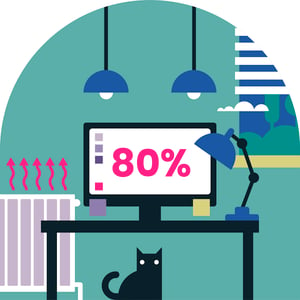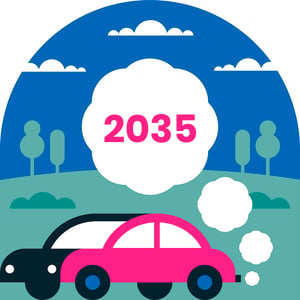The future of energy use after lockdown: 4 key questions
The Covid-19 pandemic has had a huge impact on every aspect of life, and the environment is no exception.
Reports have shown that emissions of carbon dioxide (CO2) – the main greenhouse gas, accounting for 81% of total UK greenhouse gas emissions – have fallen as lockdown brought with it huge changes to the way we create and consume energy.
In the UK, 58% of people believe the government should prioritise the environment as part of the economic recovery from Covid-19. But, with restrictions easing around the world and energy demands creeping higher again, just how possible is it to keep emissions low and what does the future look like?
Here are four key questions to consider:
1. Can we keep on working from home?
Millions of people switched to remote working when the UK went into lockdown, as businesses closed their doors and employees were asked to work from home if they could. This change in the nation’s working habits brought with it a significant reduction in the number of cars on the roads as well as a drop in the energy needed to power large office buildings and retail spaces.
It is widely thought that by maintaining these remote working habits – or at least some of them – there will be a more sustainable drop in emissions.
However, research from WSP, a London-based consulting firm specialising in engineering, suggests a need to adapt the nation’s style of working through different seasons of the year in order to lower the carbon footprint.
In the summer, working from home saves around 400kg of carbon emissions, the equivalent of 5% of a typical British commuter’s annual carbon footprint, because homeworking staff cut out their carbon emissions from their commute.
However, the firm found that if an average employee worked at home all year round, they would produce actually 2.5 tonnes of carbon per year – around 80% more than an office worker. That’s because most heating systems in the UK heat the whole house, producing far more carbon emissions than what would be produced from the commute.

So, in order to reduce carbon emissions in the longer-term, remote workers would need to consider more efficient ways of heating their home, or more efficient ways of travelling to work, factoring in the seasons too.
2. What will the travel industry look like?
Transport accounts for 23% of total carbon dioxide emissions. So, flight cancellations and travel restrictions imposed during lockdown led to dramatic declines in these emissions as the government advised people against all but essential international travel.
But with airlines starting to re-introduce more flights and air-bridges coming into effect, these emissions could begin to rise again as people take to the skies once more.
In order to reduce emissions in the longer-term and help the UK meet its target for net zero greenhouse gas emissions by 2050, more needs to be done to when it comes to travel.
Aviation is the fastest growing contributor to greenhouse gas emissions, so cutting out flying and opting for alternative ways to travel is one of the easiest ways to reduce your carbon footprint.
If you do need to fly, you can at least offset emissions; there’s plenty of information online on how best to do this.
3. Will the pandemic supercharge the electric vehicle market?
It’s not just planes that cause pollution, but the day to day means of getting around too. The government has recognised this already and in a bid to promote sales of electric cars has announced the sale of both new diesel and petrol cars will be stopped entirely in the UK in 2035. There have even been reports that the ban could take place sooner.

But as the government strives to hit tough zero-carbon emissions targets, will the pandemic supercharge the electric vehicle (EV) market?
There has certainly been a big rise in sales of greener vehicles. According to data from industry analysts Jato Dynamics, battery electric vehicles, plug-in hybrids and other hybrid cars accounted for 17% of car sales across all European markets, including the UK in April. The data also found buyers were more likely to opt for electric and hybrid cars, even as overall sales of cars fell.
As restrictions continue to ease and more people get back on the roads, interest in electric vehicles will need to remain high in order to keep emissions down.
There is already financial support in place to encourage people to go electric, as the government continues to push the future of travel towards EVs.
4. Will free electricity be part of our energy future?
It might sound counterintuitive, but during the pandemic there have been instances of consumers being paid to use energy.
Paying customers to use power is often a much simpler solution for grid operators than having to shut down generating facilities when there is too much power in the system.
During the lockdown, reports showed that electricity consumption was down by 15% across Europe, yet a very sunny and windy spring season meant that supplies of renewable energy were up.
In Europe, wholesale electricity is priced on an hourly basis for the day ahead, so high supplies and low demand mean that prices can go below zero. In fact, this happened 66 times in April in the UK.
Consumers who are signed up to flexible, Agile tariffs could find themselves encouraged to use electricity when the price goes below negative. This happened to customers of energy supplier Octopus during lockdown. Perfect for those customers with an EV or home battery to charge, or with electric water heating or indeed for those able to shift their load to periods of negative pricing.
As the UK moves towards a greener future, with more renewable energy sources in use and advances in energy storage capabilities, more and more people could get paid to use energy.
One thing is for sure: the way energy is generated, consumed and paid for in this country is going to continue to change dramatically in the years ahead.
• • •
With Loop, you can find out how you use electricity, then make smart decisions about using less - click here to find out more. We have a risk-free, no-quibble, money-back guarantee as standard, so what's to lose...apart from some £££ from your bills and some weight from your carbon footprint?







